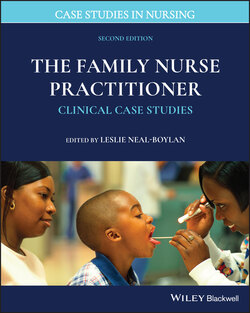Читать книгу The Family Nurse Practitioner - Группа авторов - Страница 21
ОглавлениеCase 2.3 Growth and Development
By Mikki Meadows‐Oliver, PhD, RN, FAAN
SUBJECTIVE
Kilah, a 9‐month‐old infant, presents to the office for a well‐baby visit. She is accompanied by her foster mother, Angela. Angela states that Kilah has been in her care for the past 7 months. Kilah is the first infant that Angela has cared for. According to Angela, Kilah has been healthy since her last well‐child visit at 6 months of age. She has had no visits to the urgent care clinic or to the emergency room in the interim. Angela is concerned that Kilah appears thin.
Diet: Kilah’s nutrition history reveals that she drinks three 8‐oz bottles of milk‐based formula daily. Kilah also eats 1 jar of stage 1 baby food twice daily. She is not currently taking any multivitamins.
Elimination: Angela states that Kilah has 4–6 wet diapers daily. She does not have any diarrhea or constipation.
Sleeps: Kilah sleeps 10 hours nightly and takes 2 naps daily. Angela states that Kilah does not have any problems falling asleep or staying asleep. The family does not currently have a bedtime routine for Kilah.
Birth history: Angela does not know any of the details of Kilah’s birth history or family history.
Past medical history: Kilah has been healthy since being placed in Angela’s care. Since placement, Kilah has had no injuries or illnesses requiring visits to the emergency department. Developmentally, Kilah is able to crawl. She is able to pick up small objects such as Cheerios® using only her thumb and forefinger. Kilah makes many sounds and is beginning to say “dada.”
Social history: Kilah lives at home with her foster mother, Angela. Angela does not currently work outside the home. The family receives a rent subsidy from Section 8, food subsidies from the Women, Infants, and Children (WIC) program, and food stamps. The family also receives monthly cash assistance from the Temporary Aid to Needy Families (TANF) program. The family has no pets, and there are no smokers in the home.
Medications: Kilah is not currently taking any over‐the‐counter, prescription, or herbal medications.
Allergies: Kilah has no known allergies to food, medications, or the environment. She is up to date on required immunizations.
OBJECTIVE
General: Appears thin but alert, active, and playful.
Vital signs: Weight in the office today is 6.4 kg and her length is 66 centimeters. Kilah’s temperature is within the normal range at 36.8°C (temporal). Kilah’s weight has not changed since her last well child visit.
Skin: She appears well hydrated, and her skin was clear of lesions. There is no cyanosis of her skin, lips, or nails. There was no diaphoresis noted. Kilah has good skin turgor on examination.
HEENT: Kilah’s head is normocephalic. Her anterior fontanel is open and flat (0.5 cm × 0.5 cm). Red reflexes are present bilaterally; and pupils are equal, round, and reactive to light. There is no discharge noted. Pinnae are normal; the tympanic membranes were gray bilaterally with positive light reflexes. Bony landmarks are visible and there was no fluid noted behind the tympanic membrane. Both nostrils are patent. There is no nasal discharge, and there is no nasal flaring. Kilah’s mucous membranes are noted to be moist when examining her oropharynx. She has 2 teeth present—lower central incisors. There are no lesions present on the teeth or in the oral cavity.
Neck: Supple and able to move in all directions without resistance. There are no lymph nodes present in the neck area.
Respiratory: Rate is 22 breaths per minute, and her lungs are clear to auscultation in all lobes. There is good air entry, and no retractions or grunting are noted on examination. There are no deformities of the thoracic cage noted.
Cardiovascular: Heart rate is 110 beats per minute with a regular rhythm. There is no murmur noted upon auscultation; brachial and femoral pulses are present and 2+ bilaterally.
Abdomen: Normoactive bowel sounds are present throughout; soft and nontender. There is no evidence of hepatosplenomegaly.
Genitourinary: Genitourinary examination reveals normal female genitalia.
Neuromusculoskeletal: Good tone in all extremities. She has full range of motion in all extremities and her extremities are warm and well perfused. Capillary refill is less than 2 seconds, and her spine is straight.
CRITICAL THINKING
1 Which diagnostic or imaging studies should be considered to assist with or confirm the diagnosis?___CBC count___Urinalysis___Urine culture___Electrolytes, including creatinine and BUN___Liver function tests, including total protein and albumin___Barium swallow___Chest radiograph
2 What is the most likely differential diagnosis and why?___Organic failure to thrive (FTT)___Nonorganic FTT (FTT)___Constitutional growth delay___Fetal alcohol spectrum disorder
3 What is the plan of treatment, referral, and follow‐up care?
4 Does this patient’s psychosocial history affect how you might treat this case?
5 What if the patient lived in a rural setting?
6 Are there any demographic characteristics that might affect this case?
7 Are there any standardized guidelines that should be used to assess or treat this case?
